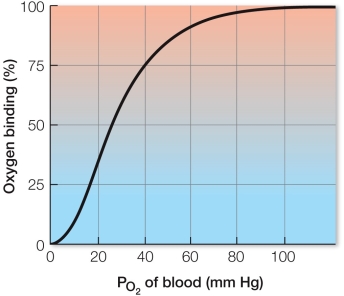Multiple Choice
Refer to the figure showing the hemoglobin-oxygen binding/dissociation curve.  Which statement about hemoglobin's O2-binding/dissociation curve is true?
Which statement about hemoglobin's O2-binding/dissociation curve is true?
A) At rest, our body's hemoglobin activity can be illustrated by only the upper one-fourth of its O2-binding/dissociation curve.
B) A smaller decrease in PO2 is required for hemoglobin to drop from 100 to 75% saturation than for hemoglobin to drop from 75 to 50% saturation.
C) Our blood normally carries a small reserve of O2.
D) The steepest part of the O2-binding/dissociation curve results in a small release of O2 for a large drop in PO2.
E) The PO2 of our blood drops well below 40 mm Hg during light exertion.
Correct Answer:

Verified
Correct Answer:
Verified
Q8: In fish gas exchange systems, blood flows
Q9: Which feature characterizes the lungs of mammals?<br>A)
Q10: Refer to the figure showing the O<sub>2</sub>-binding/dissociation
Q11: Which statement about how breathing is regulated
Q12: Refer to the graph showing several different
Q14: If a new air pollutant were to
Q15: The carotid and aortic bodies<br>A) are blood
Q16: Which statement about CO<sub>2</sub> is true?<br>A) CO<sub>2</sub>
Q17: Which feature characterizes myoglobin?<br>A) It is present
Q18: Which statement about gill circulation in fishes